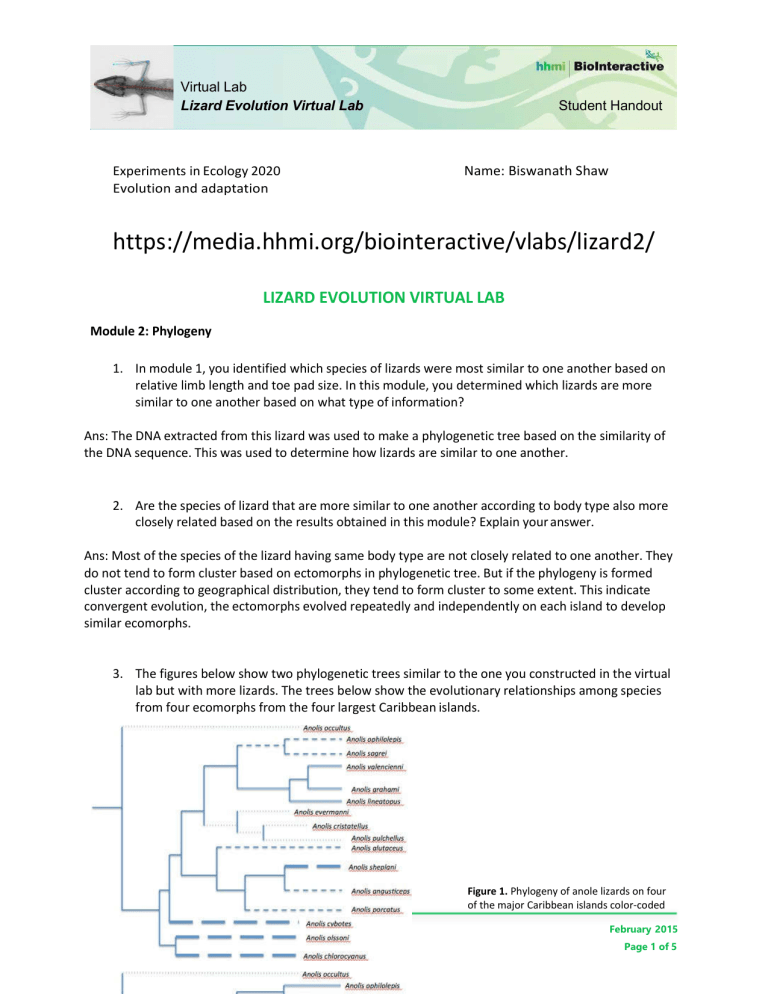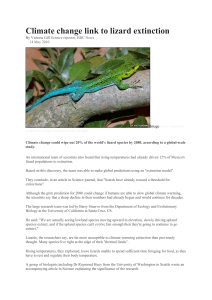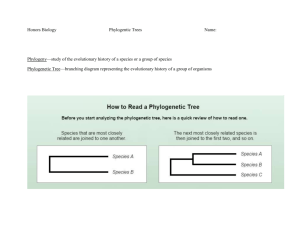
Virtual Lab Lizard Evolution Virtual Lab Experiments in Ecology 2020 Evolution and adaptation Student Handout Name: Biswanath Shaw https://media.hhmi.org/biointeractive/vlabs/lizard2/ LIZARD EVOLUTION VIRTUAL LAB Module 2: Phylogeny 1. In module 1, you identified which species of lizards were most similar to one another based on relative limb length and toe pad size. In this module, you determined which lizards are more similar to one another based on what type of information? Ans: The DNA extracted from this lizard was used to make a phylogenetic tree based on the similarity of the DNA sequence. This was used to determine how lizards are similar to one another. 2. Are the species of lizard that are more similar to one another according to body type also more closely related based on the results obtained in this module? Explain your answer. Ans: Most of the species of the lizard having same body type are not closely related to one another. They do not tend to form cluster based on ectomorphs in phylogenetic tree. But if the phylogeny is formed cluster according to geographical distribution, they tend to form cluster to some extent. This indicate convergent evolution, the ectomorphs evolved repeatedly and independently on each island to develop similar ecomorphs. 3. The figures below show two phylogenetic trees similar to the one you constructed in the virtual lab but with more lizards. The trees below show the evolutionary relationships among species from four ecomorphs from the four largest Caribbean islands. Figure 1. Phylogeny of anole lizards on four of the major Caribbean islands color-coded www.BioInteractive.org February 2015 Page 1 of 5 Virtual Lab Lizard Evolution Virtual Lab Student Handout according to geographical distribution. Light dotted line, Puerto Rico; small dashed line, Cuba; large dashed line, Hispaniola; and solid line, Jamaica. Figure 2. Phylogeny of anole lizards in the four major Caribbean islands colored in according to ecomorph. Light dotted line, twig; small dashed line, trunk-ground; large dashed line, trunk-crown; solid line, grassbus www.BioInteractive.org February 2015 Page 2 of 5 Virtual Lab Lizard Evolution Virtual Lab Student Handout What conclusion can you draw about the evolution of the Anolis lizards based on these figures? Answer: When we look at the phylogenetic tree pattern-coded based on islands we see that they seem to cluster together somewhat: Three of the Jamaican species cluster together as three of the four Peurto Rican species. Cuban and Hispaniola species also cluster but the pattern is more complicated. If we look at the phylogenetic tree color-coded based on the ectomorphs we see that there is no clear pattern except for the two twig species. The phylogenetic tree suggest that the species from the same islands are more closely related than are species from same ecomorph group. The phylogenetic tree suggest the hypothesis of convergent evolution. 4. What is convergent evolution? Use evidence from the trees to explain how the Anolis lizards are an example of this concept. Answer: Organisms in having different evolutionary history, independently evolving similar traits to adapt to similar environments or ecological niches is known as convergent evolution. If we analyze the tree, three of the Jamaican species cluster together as three of the four Peurto Rican species. Cuban and Hispaniola species also cluster but the pattern is more complicated. If we look at the phylogenetic tree color-coded based on the ectomorphs we see that there is no clear pattern except for the two twig species. The phylogenetic tree suggest that the species from the same islands are more closely related than are species from same ecomorph group. The phylogenetic tree suggest the hypothesis of convergent evolution. Module 3: Experimental Data 1. In Dr. Losos’s experiment, why was it important that the experimental islands lacked lizards? Answer: It was important for Dr. Losos’s experiment to have no lizard is because it allowed each ecomorph to be isolated and made it easier to study evolution. The data collected won’t be affected by the lizards originally present there and would help us to compare it with the other islands or originals species. 2. Dr. Losos’s data suggest that after only a few generations, the lizards on the experimental islands have shorter legs on average than the lizards on the larger island. Explain how the data you collected either supports or does not support this claim. Answer: Mean Relative Hindlimb length Experimental Island : 0.831 +/- 0.016 Iron Cay( Larger island): 0.871 +/- 0.01 www.BioInteractive.org February 2015 Page 3 of 5 Virtual Lab Lizard Evolution Virtual Lab Student Handout For some technical reason, the site did not return error bar for Iron Cay group, so I added a error bar using word. The data collected support this claim as there is a significant difference relative hindlimb length even after considering the error bar. 3. Based on what you know about the experimental islands and the lizards that were placed on these islands, explain how and why the average leg length of the population might change over time. Include the concept of natural selection in your discussion. Ans : The average relative length of the hindlimb decreases in the population because in the experimental island, the longer legs served no advantage while the shorter legs provided with some advantage. Therefore the lizards having the smaller legs have higher chances of survival, as they would live longer and reproduce more compared to longer legs, due to natural selection, shorter legs would have increased number in population 4. If the population from one of the experimental islands were reintroduced on the original island, do you predict that lizards from the two populations would still mate and reproduce? Justify your answer with scientific arguments. Ans : I still think the lizard of experimental island would still be able to mate and reproduce with the original island populations. In order to develop reproductive barrier it requires lot more time on evolutionary scale to accumulate changes that makes breeding not possible. The duration of experiment was no that long that it would be enough to develop reproductive barrier. www.BioInteractive.org February 2015 Page 4 of 5 Virtual Lab Lizard Evolution Virtual Lab Student Handout Extension Questions 1. To minimize interspecific competition, organisms often divide the limited available resources in an area, a concept called “resource partitioning.” As an example of this concept, the figure below illustrates how different species of warblers utilize different portions of an individual tree. Figure 3. Different species of North American warblers live in different parts of the same trees. The shaded areas indicate the habitats each warbler species occupies. Explain how the different species of anoles on an island demonstrate “resource partitioning” similar to the warblers in the figure. Answer: Each of the species of ecomorphs of anoles has developed features to be successful in particular habitat such as canopy, trunk-crown, trunk, twig, trunk-ground and garden bush, thereby partitioning the resources among themselves. They live in separate environment just as the warblers have divided the divided the different sections of tree. 3. Explain how resource partitioning can promote long-term coexistence of competing species, thus increasing biodiversity. Ans: Resource partitioning can promote long term coexistence by minimizing competition. There is less competition because the resources are divided, therefore the more powerful species does not tend to weaker species extinct by taking away all the resources, promoting coexistence. www.BioInteractive.org February 2015 Page 5 of 5

